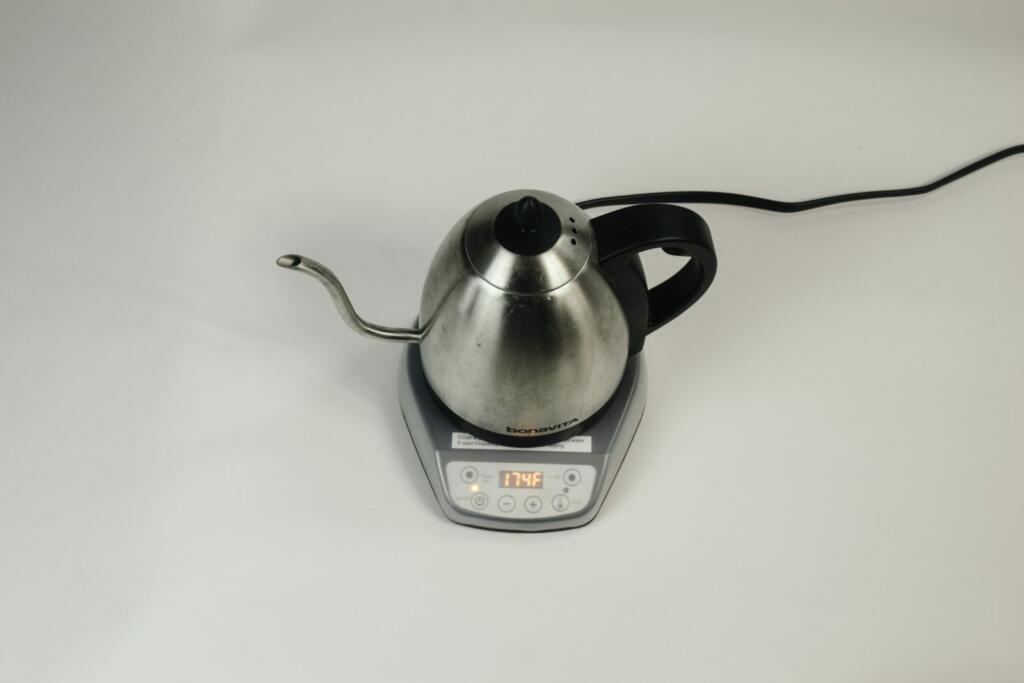Don’t let your electric kettle become a breeding ground for bacteria and limescale. Keeping it clean is easy and takes only a few minutes.
Table Of Contents
−- Why should I clean my electric kettle?
- What is the buildup in an electric kettle?
- How often should an electric kettle be descaled and cleaned?
- How To Clean Your Electric Kettle
- 1. Unplug the electric kettle
- 2. Drain and disassemble
- 3. Clean the outside of the kettle
- 4. Remove mineral deposits
- 5. Boil white vinegar solution
- 6. Rinse with water and dry thoroughly
- 7. Clean the inside of the kettle with baking soda and vinegar solution
- 8. Clean the inside of the kettle with lemon juice or citric acid solution
- 9. Clean the filter screen regularly
- How to remove rust from a kettle
- Tips for keeping your electric kettle cleaner for a longer period
- Conclusion
In this blog post, we’ll show you the best way to keep your electric kettle in top condition, so you can enjoy hot drinks without worrying about the safety of your appliance.

Why should I clean my electric kettle?
Because it is used for heating water, having any mineral accumulation is natural for the kettle, just as your coffee maker does. Luckily, it’s really easy to clean.
What is the buildup in an electric kettle?
Calcium deposits from natural minerals can form whenever you boil the water in a kettle. The rate at which these deposits accumulate is most likely related to the water quality in your house. In addition, this accumulation might impact the flavor of your hot drinks.
How often should an electric kettle be descaled and cleaned?
To ensure that your morning cup of tea tastes great, clean your electric kettle as a normal routine and descaling it regularly per month if you use it.
Descaling is the process that eliminates limescale accumulation within your kettle, which is caused by calcium, magnesium, and other minerals in your water. Because hard water contains more minerals than soft water, you will also need to descale your electric kettle more frequently if you have it.

How To Clean Your Electric Kettle
Cleaning your electric kettle is easy and requires only a few common home materials. To keep the kettle’s exterior clean daily, use a moist towel to eliminate any water splashes or residue, then wipe and polish with a clean cloth.
Inside cleaning and descaling: You only need one cup of white vinegar to clean or descale the interior.
1. Unplug the electric kettle
Unplugging the electric kettle is the first step in cleaning it. NEVER start cleaning your kettle while it’s plugged in. Make sure you unplug it and turn off the power switch. Also, ensure your hands are dry before touching the electric kettle or its cord. Doing so will ensure your safety and prevent any electrical shocks.
2. Drain and disassemble
Before beginning the cleaning process, unplug the electric kettle and drain any water left inside. Next, disassemble the kettle, removing the lid and filter screen where possible. Place the components on a clean towel to prevent the counter from getting wet. If your electric kettle comes with a removable base, take it off.
3. Clean the outside of the kettle
Cleaning the outside of an electric kettle is simple. Unplug the kettle, then wipe it down with a damp cloth and dish soap. Be careful not to get any soap inside the kettle. Once you have wiped the outside down, dry it with a clean cloth.
If you have distilled white vinegar on hand, you can use it to give the kettle an extra shine. Mix equal parts water and vinegar in the kettle, and bring it to a boil. Allow it to sit for 20 minutes, pour out the solution and dry the outside of the kettle.
4. Remove mineral deposits
Removing mineral deposits from your electric kettle can be done using a mixture of water and vinegar or water and lemon. Fill the kettle ¾ full with either water and one lemon or equal parts water and vinegar (household vinegar is fine). Let it soak for one hour, then boil the kettle three times for the lemon mixture and once for the vinegar.
Allow it to cool, then rinse thoroughly. For deeper cleaning, you can use a solution of white vinegar and water to remove more stubborn mineral deposits. Mix 2 cups of water and 2 cups of white vinegar in a large bowl.
Pour the solution into your electric kettle and let it sit for an hour before boiling. Once boiled, discard the solution and rinse the kettle thoroughly with clean water. You may need to scrub any remaining mineral deposits with a soft brush or sponge.
5. Boil white vinegar solution
For more thorough cleaning, boiling a white vinegar solution in the kettle can help remove mineral deposits and odors. To do this, fill the kettle with equal parts water and distilled white vinegar and bring it to a boil. Allow it to sit for 15-20 minutes before pouring the mixture and rinsing it with clean water.
This method is safe and effective for descaling your electric kettle, as vinegar’s mild acidity helps break down limescale and other stubborn residue.
6. Rinse with water and dry thoroughly
Rinsing your electric kettle with water is an important step in the cleaning process. Be sure to rinse off any leftover vinegar or lemon juice. Once you’ve done this, dry the kettle thoroughly, either by hand or in the dishwasher. Be sure to pay special attention to the base of the kettle and any crevices where water can easily accumulate. This will help prevent mineral deposits and mold from forming.
7. Clean the inside of the kettle with baking soda and vinegar solution
Cleaning the inside of an electric kettle with baking soda and vinegar is a great way to remove limescale, mineral deposits, and stubborn residue. To start, scoop 1 to 2 teaspoons of baking soda into the kettle and add water to at least the halfway mark. Boil the kettle, then leave it for 20 minutes to soak.
After boiling, gently scrub the inside with a soft sponge. For a minor mineral deposit inside the kettle, limited to the bottom and low areas of the sides, pour several tablespoons of baking soda into the kettle and fill it with a 1:1 solution of water and distilled white vinegar.
Allow it to stand for 20-30 minutes, then scrub the inside with a soft sponge. To eliminate limescale, clean the kettle regularly by sprinkling baking soda and scrubbing the inside with a soft sponge. To remove limescale from the kettle’s filter, remove it and soak it in a cup of vinegar for 10 minutes to loosen up the stubborn residue.
8. Clean the inside of the kettle with lemon juice or citric acid solution
Cleaning the interior of your electric kettle with lemon juice or citric acid is a natural and non-toxic way to descale and keep your kettle in top condition. This method is easy and quick, and it’s also a great way to preserve the flavor of your tea or coffee without any unpleasant metallic taste.
To clean and descale the inside of your kettle with lemon juice, cut a whole lemon in half and squeeze the juice into your kettle. Alternatively, you can use citric acid instead. Fill half of the kettle with water and bring it to a boil. Once boiling, add 2 tbsp of citric acid and let it sit for 20 minutes. Finally, rinse with plenty of water and dry thoroughly.
These natural methods are safe for most electric kettles, but always check the manufacturer’s instructions for cleaning first. Regularly cleaning an electric kettle with lemon juice or citric acid can help keep it looking new for years to come.
9. Clean the filter screen regularly
Regularly cleaning the filter screen of your electric kettle is essential to keep it in good working condition. Over time, limescale, minerals, and other debris can build up on the filter screen, making it difficult for water to flow through.
To clean the filter, unplug the kettle and remove the filter. Rinse the filter under a running tap and use a soft nylon brush to scrub any buildup. If there is excessive limescale buildup, soak the filter in vinegar and water for a few minutes before rinsing. After cleaning, dry the filter thoroughly before replacing it in the kettle.

How to remove rust from a kettle
Kettles are frequently filled with water; if you leave them in an area with hard water and moisture left in the kettle, they can rust. Just wash it off after each use to keep rust from accumulating in your kettle.
If you have rust on your cast iron kettle, you may be able to remove it by gently cleaning the rust stains with a wire brush. Rinse the remains with cool water. If there are still rust spots on the kettle, immerse it in Coca-Cola. Pour enough cola to fill the bottom and set it aside for 20 minutes. If there is a bunch of rust left, you may need to soak it overnight. Dump the cola and thoroughly rinse the kettle with warm water.
Tips for keeping your electric kettle cleaner for a longer period
Never leave water in a kettle unattended. Learn to heat as much water as you need for each usage. Always drain the kettle completely after each use. (Use the leftover water to irrigate plants or clean the sink.)
Instead of tap water, use distilled water. This is especially crucial if you live in a hard water location or rely on a natural well for your water source.
Keeping your electric kettle covered when not in use is a great way to ensure it stays clean for longer. This is because a covered kettle is less likely to accumulate dust, dirt, and other particles that can contribute to the buildup of mineral deposits.
Additionally, keeping your kettle covered will help reduce the amount of moisture that can settle on the inside, which can also cause mineral deposits to form. Remember to keep your electric kettle clean and in good working order; always keep it covered when not used!
Conclusion
Keeping your electric kettle clean and free from limescale buildup is an important part of its maintenance. With the right tools and techniques, you can ensure that your electric kettle is always in good condition.
You can use baking soda, vinegar, lemon juice, citric acid, and dish soap to clean and descale your electric kettle. Regular cleaning and maintenance will help extend the life of your electric kettle and keep it working in top condition. Additionally, make sure to cover your kettle when not in use and choose a high-quality model to ensure the best performance.

Editorial Staff
The editorial staff at Crazy Coffee Crave is a team of coffee enthusiasts & Baristas who enjoy the one thing we all think about as soon as we get up in the morning. Trusted by thousands of readers worldwide.





